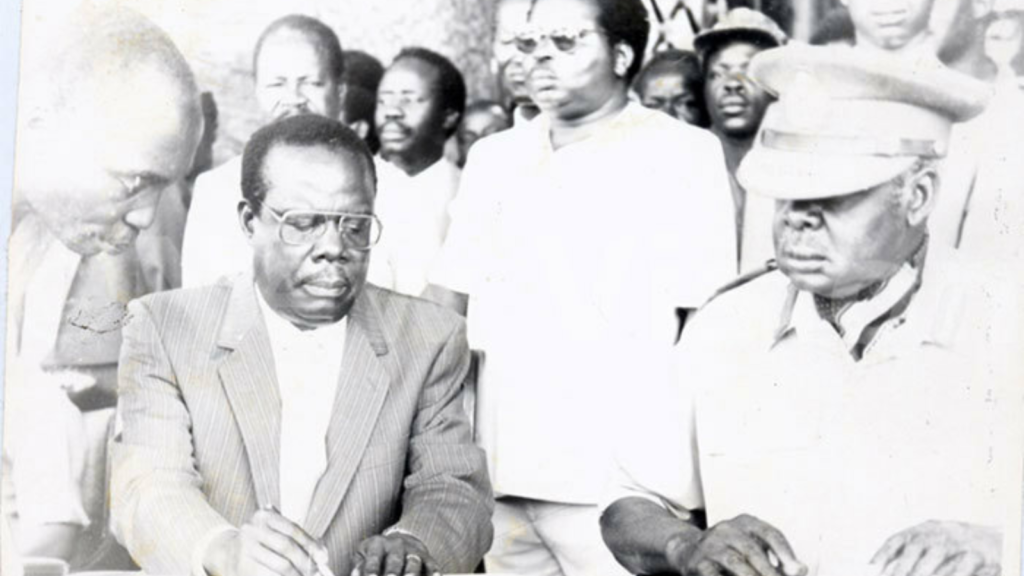The period between 1979 and 1986 in Uganda was marked by significant political upheaval and transitions following the fall of Idi Amin.
Here’s a detailed overview of the constitutional and political history during this time, including key events and figures:
Transition after Amin
- Moshi Conference (1979):
– Held in Tanzania, this conference was crucial for Ugandan political leaders and various opposition groups to discuss and create a plan for the future of Uganda. Delegates included former political members from different factions.
– The conference aimed to establish a broad-based government and create a framework for democratic governance.
– Overall, the conference plotted a forceful removal of President Idi Amin from power. - Fall of Amin (1979): With the ousting of Idi Amin by Tanzanian forces and Ugandan rebels, Uganda faced a power vacuum and the challenge of restoring governance.
Key Political Figures
- President Lule (1979):
– After the Moshi Conference, Professor Yusuf Lule was appointed as the first president of the Uganda National Liberation Front (UNLF), leading a transitional government.
– His presidency was short-lived; he faced challenges in reconciling various political factions and managing a country in turmoil. - Binaisa (1979-1980):
– Following Lule’s resignation in June 1979, Godfrey Binaisa was appointed president. He struggled to maintain authority and faced opposition within the UNLF.
– Binaisa’s government attempted to restore order but was unable to effectively deal with economic problems and political unrest, leading to further instability. - Defacto President Muwanga (1980):
– In 1980, the military ousted Binaisa, and Paulo Muwanga, a member of the military junta, assumed power as the de facto leader.
– Muwanga’s leadership was marked by the consolidation of military power and suppression of political dissent.
Obote II (1980-1985)
Return of Obote:
– Milton Obote returned to power after elections held in December 1980 amidst allegations of electoral fraud. His party, the Uganda People’s Congress (UPC), won the elections, but the legitimacy was widely disputed.
– Obote II faced challenges from various political factions, including dissatisfaction among rebels and continued unrest.
Conflict and Suppression:
– Obote’s government was marked by repression of opposition, particularly against the Popular Resistance Army (PRA) led by Yoweri Museveni.
– His regime faced increasing resistance, particularly from the Acholi and Langi ethnic groups who had supported Amin and were now unhappy with Obote’s rule.
The Acholi Generals
Tito Okello and Basilio Okello:
– Both generals were key military figures who played significant roles in the political landscape during this time.
– Tito Okello led the Military Commission responsible for the military administration of Uganda and had significant influence in Uganda’s military operations.
– Basilio Okello was involved in various military campaigns and governance issues concerning the regime.
Fall of Obote and Museveni’s Rise (1985-1986)
- Military Coup (1985):
– In July 1985, a coup led by Tito Okello and other military officers ousted Milton Obote, marking the end of his controversial rule.
– Okello assumed control of the government, but the new regime faced immediate challenges, including ongoing rebellion from Museveni’s National Resistance Army (NRA). - National Resistance Army (NRA):
– As civil unrest continued, Yoweri Museveni’s NRA gained support, particularly in the western and central parts of Uganda. The NRA capitalized on public discontent with the Okello regime.
– The NRA launched a full-scale offensive against the government, culminating in a series of military victories. - Museveni Takes Power (1986):
– In January 1986, Museveni and the NRA captured Kampala, leading to the collapse of Okello’s government. Museveni assumed the presidency and initiated significant reforms aimed at rebuilding Uganda.
Conclusion

